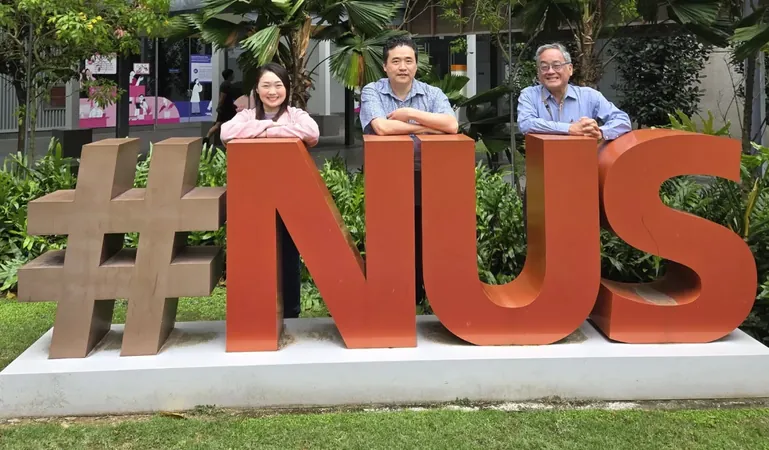
Quantum Computing Revolutionizes Classical Fluid Dynamics: A Leap Towards the Future!
2025-03-25
Author: Siti
Introduction
In a groundbreaking study from the Department of Energy's Oak Ridge National Laboratory (ORNL), researchers have ventured into the fascinating realm of quantum computing to tackle the age-old challenges associated with classical fluid dynamics. This innovative research, documented in the journal Physics of Fluids, shines a light on the future possibilities of integrating quantum mechanics with scientific inquiry.
The Hele-Shaw Flow Problem
The team focused on the Hele-Shaw flow problem, an idealized scenario involving two flat, parallel plates placed extremely close together, through which liquids and gases flow. While this scenario is theoretical, it has significant real-world implications in diverse fields including microfluidics, groundwater movement, oil recovery, and bioengineering.
Research Objectives
Their investigation sought to determine if quantum algorithms, when executed on quantum computers, could outperform classical computers in solving flow equations swiftly and accurately. "Scalability and accuracy are the key issues here," stated Murali Gopalakrishnan Meena, the lead author and a computational scientist at ORNL. "We demonstrated that error suppression and mitigation techniques can facilitate progress, but further research is crucial."
Importance of Fluid Flow Modeling
Fluid flow modeling is pivotal in various industries, impacting everything from aerodynamics in aviation to processes in oil refining. Traditional methods often employ a mix of expensive physical testing and complex equations that can be inadequate in reflecting all physical variables involved. Although digital simulations can provide more comprehensive physics capture, they often demand extensive computational resources and time.
Quantum Advantage in Fluid Dynamics
"On paper, there’s a quantum advantage to be achieved for this problem," Gopalakrishnan Meena added. However, the primary goal of their study was to establish benchmarks that would guide future applications of quantum algorithms in fluid dynamics.
Quantum Computing Mechanism
Quantum computing operates using quantum bits, or qubits, which can exist in multiple states simultaneously thanks to the phenomenon of quantum superposition. This capability may lead to faster and more efficient solutions for complex problems, such as fluid flow predictions.
Challenges Encountered
Despite the theoretical advantages, the research team encountered significant challenges when configuring the problem for effective quantum solutions. They obtained computing time on two of IBM's quantum computers through the Quantum Computing User Program (QCUP) to support their project, employing the Harrow-Hassidim-Lloyd (HHL) algorithm, known for solving linear equations.
Error Sensitivity in Solutions
The effectiveness of the HHL algorithm in addressing the Hele-Shaw problem hinges on the system’s susceptibility to minor numerical inaccuracies. "The sensitivity of the equations grows exponentially with our problem size, so even a tiny numerical error can render the entire solution unworkable," Gopalakrishnan Meena explained. Thus, the team attempted to structure the problem to minimize errors.
High Error Rates in Quantum Systems
One of the significant issues within current quantum systems is the prevalent high error rates attributed to measurement inaccuracies and qubit degradation. While the researchers tried to implement noise models to mitigate these errors, they found limited success. "We discovered that the noise models failed to replicate the actual behavior of the quantum circuits," Meena noted. However, when they streamlined the circuit operations, they observed an increase in overall accuracy.
Future Directions
As a result, the team advocates for more advanced noise models, especially for larger problem sets, along with a more profound emphasis on optimizing circuit designs for future investigations. "The scalability of the quantum algorithm and the suitability of the problem for the quantum method are paramount," Meena asserted. They are currently exploring the recent advancements in the HHL algorithm to further address fluid dynamics challenges.
Conclusion and Potential Applications
If successfully harnessed, quantum algorithms such as the HHL could offer substantial real-world applications in fluid dynamics—from enhancing combustion processes to breakthroughs in fusion technology. This pioneering work showcases how quantum computing could unlock unprecedented capabilities in scientific exploration and industry, laying the groundwork for future advancements in fluid dynamics and beyond!





 Brasil (PT)
Brasil (PT)
 Canada (EN)
Canada (EN)
 Chile (ES)
Chile (ES)
 Česko (CS)
Česko (CS)
 대한민국 (KO)
대한민국 (KO)
 España (ES)
España (ES)
 France (FR)
France (FR)
 Hong Kong (EN)
Hong Kong (EN)
 Italia (IT)
Italia (IT)
 日本 (JA)
日本 (JA)
 Magyarország (HU)
Magyarország (HU)
 Norge (NO)
Norge (NO)
 Polska (PL)
Polska (PL)
 Schweiz (DE)
Schweiz (DE)
 Singapore (EN)
Singapore (EN)
 Sverige (SV)
Sverige (SV)
 Suomi (FI)
Suomi (FI)
 Türkiye (TR)
Türkiye (TR)
 الإمارات العربية المتحدة (AR)
الإمارات العربية المتحدة (AR)